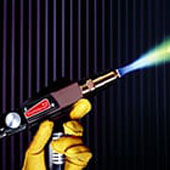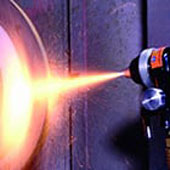
 Corrosion and wear resistant surfaces are needed for machine parts in many industries. The HVOF liquid fuel process supplies this protection by producing very thick, high-density coatings.
Corrosion and wear resistant surfaces are needed for machine parts in many industries. The HVOF liquid fuel process supplies this protection by producing very thick, high-density coatings.
Process description
For High Velocity Oxygen (liquid) Fuel (HVOF) spraying, we use an oxygen-kerosene mixture. We axially feed the coating material, in powdered form, through the gun, generally using nitrogen as a carrier gas. The fuel is thoroughly mixed with oxygen within the gun and the mixture is then ejected from a nozzle and ignited outside the gun. The ignited gasses surround and uniformly heat the powdered spray material as it exits the gun and is propelled onto the workpiece surface.

| Heat source | Fuel (liquid) and Oxygen |
| Material | Powder (Metal) |
| Arc temperature | Approx. 2,800 °C |
| Particle velocity | 400 – 800 m/s |
| Spray performance | 70 – 200 g/min |
Key characteristics
| Produces coatings that are very clean, hard, and dense with fine, homogeneous structures |
| Coatings are tenaciously bonded to the substrate |
| Has low compressive stress, which results in very thick coatings |
Typical applications
| Gate valves |
| Pelton turbines |
| Ball valves |




